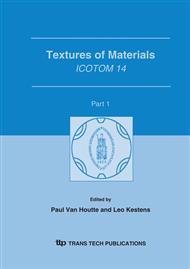p.1079
p.1085
p.1091
p.1097
p.1103
p.1111
p.1121
p.1131
p.1141
Texture Prediction of an AA3004 Aluminum Alloy with the Occurrence of Strain Localization during Simple Shear Using a Multi-Scale Modeling Procedure
Abstract:
Although the Taylor-type models gives reasonable texture prediction of the monotonic cold deformation of annealed aluminum alloys both qualitatively and quantitatively, results are less satisfactory for the simple shear test when the alloy is heavily pre-deformed by cold rolling. The reason for this less good prediction originates from strain localization. A virtual stress-strain curve is proposed in which the texture aspects are dealt with by the FC Taylor simulation and the microstructure aspects by a model for the development of intragrain dislocations structure. This virtual yield law is used in a finite element simulation. A strain localization behavior is observed during the finite element simulation similar to that observed during experimental simple shear test. The strain profile of a specific global strain is discretized into a series of strain and the volume fractions of the regions deformed to these strain levels, using the statistical method of histogram. A secondary FC-Taylor simulation is performed, in order to generate the deformation textures, corresponding to this series of deformation strains. The global texture is generated by merging these textures with consideration of these volume fractions. Using this procedure of multi-level modeling, quite satisfactory texture prediction is observed, compared with the measured texture at this strain.
Info:
Periodical:
Pages:
1103-1110
Citation:
Online since:
September 2005
Authors:
Price:
Сopyright:
© 2005 Trans Tech Publications Ltd. All Rights Reserved
Share:
Citation:


